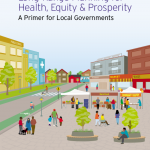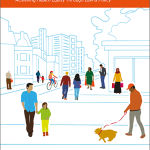By Natalia Babenko, Shauneequa Owusu & Spring Cutter
Today, adults are living longer than any generation in our history. Despite prevailing narratives about aging and decline, older adults are healthier than ever before; they are experienced and independent and offer vital contributions to our economy, our society, and our future generations. Yet negative stereotypes about aging continue to shape systems and structures that inhibit older adults from living full, vibrant lives.
The experience of aging is as diverse as the experience of individuals through their youth and early adult years. Counter to common misconceptions about diminishing quality of life, adults desire many of the same things in their later years as they do in their early lives: purpose-driven work, vibrant social communities, continued learning, independence, and much more. Supporting older adults benefits society as a whole; older populations often provide vital caregiving support, fulfill volunteering needs, facilitate community building, and provide opportunities for intergenerational relationships. As the fastest-growing sector of the workforce, older adults are also essential to the health of our economy.
May marks Older Americans Month, and this year’s theme, Flip the Script on Aging, focuses on transforming how society perceives, talks about, and approaches older communities. Now is the time for policymakers to move past limiting narratives on aging and commit to implementing age-friendly policies rooted in health equity. Even within our shifting political landscape, as federal policies like the Older Americans Act are cut back, myriad bright spots of states and localities across the political spectrum are shaping policies that allow older adults to thrive.
Advancing Health Equity for Older Populations
The current older population is the largest cohort of seniors the world has seen. By 2050, the number of US adults aged 65 and older is expected to increase by almost 50%, and by 2034, older adults are projected to outnumber children under 18 in the United States. This demographic shift presents a significant opportunity for policymakers and communities to redefine systems to better support older populations.
A key part of this shift lies in addressing structural discrimination toward older adults — a macro-level driver of health inequities. Age-related discrimination — ageism — results in limited access to resources, health care, and job opportunities. Ageism also has significant health implications; it is associated with a 7.5-year reduction in life expectancy and profoundly affects the mental health and well-being of older adults. Economically, ageism contributes to an estimated $850 billion in unrealized GDP due to underemployment and involuntary retirement of older adults, in addition to $63 billion in excess annual health care costs associated with severe health conditions. Additionally, ageism has a compounding effect on marginalized groups, including people who are disabled; have low income; are Black, indigenous, or other older adults of color (BIPOC); or are part of LGBTQ+ communities. Combating ageism is a key component of achieving health equity, and it has multi-tiered benefits for individuals as they age, for our economy, and for society as a whole.
Social Determinants of Health & Age-Friendly Initiatives
Health inequities can have a cumulative effect over the course of a person’s life, which contributes to higher disparities in health and well-being for older people. Disparities are particularly acute for older adults from historically and currently marginalized groups. While law and policy have been central to creating today’s health disparities, those same tools can be used to create positive change. Strategic intervention using law and policy to address distributions of money, power, and resources can undo fundamental drivers of inequity so that older adults can live their fullest lives.
Addressing the health inequities that older adults experience involves creating public policies that remove systemic obstacles and address the social determinants of health (SDOH) — the conditions in environments where people are born, live, learn, work, play, worship, and age that affect a wide range of health, functioning, and quality-of-life outcomes and risks. SDOH have a significant impact on our ability to stay healthy as we age and are key levers for advancing health equity. Recognizing the role that our social and physical environments play in how we age, in 2010 the World Health Organization (WHO) established the Global Network of Age-friendly Cities and Communities. This initiative focuses on action at the local level that fosters full participation of older people in community life and promotes healthy and active aging. The social determinants of health are an important part of this framework, mapping onto the domains of the Age-friendly City and Community initiative.
Creating laws and systems that support healthy aging will require coordinated action from partners across several levels of government and broad networks of policy actors at the local level. Utilizing good governance practices, local and state governments can reduce health inequities by shifting power to communities and synchronizing efforts across aging, disability, BIPOC, and LGBTQ+ communities in pursuit of shared goals. Amid the changing demographics of our older population, communities and governments should implement healthy aging as a core component of public health efforts, with a foundational focus on health equity.
A Shifting Federal Landscape
Federal action shapes the health and care access of older populations across the country. Instead of increasing support at a time when our older population is growing, current federal efforts are in the process of reducing and fragmenting essential services that support independence, health, and quality of life for older adults and their families.
The Older Americans Act (OAA) is a comprehensive policy vehicle that underpins vital community-based services such as meal delivery, caregiving support, transportation, and access to senior centers — resources that enable older adults to live independently in the community. Yet through the planned restructuring of the US Department of Health and Human Services, which includes the dismantling of the Administration for Community Living — the agency that administers the Older Americans Act — the coordinated structure of OAA would be scattered, with many programs scaled back or eliminated entirely. This restructuring would expose older adults, especially those with low incomes or limited family support, to greater risks of food insecurity, unmanaged chronic conditions, hospitalization, and premature death, ultimately deepening existing health inequities. If enacted, these policy shifts would erode the systems that safeguard the health, dignity, and independence of millions of older adults.
Compounding the rollback of OAA, the dissolution of the Administration for Community Living additionally threatens the delivery of essential community-based services that support aging in place. Without programs such as Meals on Wheels and the Low Income Home Energy Assistance Program (LIHEAP), many older adults risk losing access to daily nutrition and the ability to maintain safe, heated homes. In addition, proposed increases in work requirements for the Supplemental Nutrition Assistance Program (SNAP) would jeopardize older adults' access to food benefits, since for the first time in the program’s history, persons aged 55-64 would need to meet the work requirement. Simultaneously, proposed cuts to Medicaid would significantly reduce access to health care for the more than 7 million seniors with low income who use the program, while continued cuts to Medicare reimbursement discourage providers from serving older populations.
While the changing federal landscape poses severe harm for the health and well-being of older adults, local and state governments, which are closest to the communities they serve, are in a strategic position to close the widening health gap, and many are taking action by maximizing existing resources and leveraging multi-sectoral partnerships to create age-friendly environments.
Age-Friendly Practices Across State & Local Jurisdictions
The drivers of health inequity are created and influenced by laws and policies enacted not only by the federal government but by each state and many thousands of regional and local governments. Collective action to reduce health disparities is most successful when it begins at the local level, because local policy change is more likely to be grounded in a deep understanding of the health needs, community goals, and lived experiences of residents. Promoting age-friendliness through health equity has broad bipartisan support, and there are many bright spots across the country as states, cities, and counties prioritize healthy aging to uplift entire communities.
Ohio
Nearly a quarter of Ohio’s population is age 60 or older, and through its 2023–2026 State Plan on Aging, Ohio has developed a comprehensive roadmap anchored by a bold goal to ensure that all residents live longer, healthier lives with dignity and autonomy and that disparities and inequities are eliminated. Development of the plan is rooted in three phases of stakeholder engagement and data collection activities to assess the needs of older residents and caregivers. The plan aims to reframe how Ohioans view aging and approach the aging process, and it centers the importance of addressing social determinants of health. Specific policy priorities include improving financial stability, housing quality and affordability, transportation access, nutrition and physical activity, access to care, and social inclusion. Further, the plan highlights opportunities to advance elder justice and equity, which serve as key guiding principles. As a result of this plan, Ohio’s fiscal year 2024–2025 state budget includes $40 million for healthy aging grants and makes investments to bolster the direct care workforce in the state.
Mississippi
The state of Mississippi is taking an expansive approach to support the health and well-being of a growing population of older adults, which make up 22% of the state’s population, by building an age-friendly ecosystem. The state’s ecosystem includes Age-Friendly Health Systems with three participating sites and five local communities that are recognized by the AARP Network of Age-Friendly States and Communities. Mississippi University, which has an Age-Friendly University designation, prioritizes recognition of the educational needs of older adults, promotes career development in the second half of life, and is an early adopter of the Age-Friendly Public Health System (AFPHS) framework, which ensures that healthy aging is elevated as a core function of the state’s health department. The Mississippi State Health Department’s statewide action outlines strategies that include addressing social determinants of health that are critical for successful aging, planning and maintaining the built environment to support healthy aging within the community, and informing state and local policies on how to be inclusive of older adults. These strategies include proactively working with state agencies that represent a variety of sectors in order to remove policy barriers and embed healthy aging in all policies.
Evanston, Illinois
The City of Evanston, Illinois, has been building toward becoming a livable community for all ages. Age-Friendly Evanston was established in recognition of the important role that older adults play in the community. Guided by a multi-sector taskforce, Evanston developed a citywide action plan that engaged community residents and aligned the city’s livability goals to make it more age-friendly. As a result, Evanston received the WHO and AARP age-friendly designations, joining a network of age-friendly cities across the country and around the world. The plan includes strategies such as expanding affordable housing through community land trusts, designing a comprehensive intra-city transportation network, applying an age-friendly lens to all projects and programs, and development of an age-friendly business certification program.
Mecklenburg County, North Carolina
In North Carolina, Mecklenburg County established Age-Friendly Mecklenburg in 2021, receiving its designation from AARP and WHO. Development of the age-friendly action plan involved engaging a multi-sectoral advisory committee, community stakeholders, and over 1,100 community residents from across county districts. The plan focuses on strategies that will help older adults remain active, become better informed about events in the community, and increase social connection; improve community awareness of the needs and contributions of older adults; and support older adults so that they feel safe and secure. Mecklenburg County has made significant progress, including implementing Vision Zero education for adults who live in senior housing communities, to support pedestrian safety; a grant program to support older adults with rising homeownership costs; and a mobile market program to address barriers to accessing healthy foods.
A Path Forward: Implementing Age-Friendly Initiatives
Older adults are a dynamic population that deserves to age with dignity. As the population of older adults grows, policymakers have an urgent opportunity to shift laws and policies away from outdated policies centered on the myth of aging and decline, to support older adults in living vibrant, healthy, and autonomous lives.
Policy curtailments at the federal level will severely affect the health and security of aging populations, but despite federal trends, states and localities can implement age-friendly laws and policies that address social determinants of health. As part of a long-term strategy for achieving health equity and healthy aging, local changes can provide case studies and evidence of success, which can set the stage for state or national changes in the future.
Examples from Mississippi to Ohio and beyond show that states and localities are taking comprehensive action, rooted in community engagement, to improve the health and well-being of older adults. The data are clear that incorporating age-friendly initiatives and practices has a significant impact on our society, boosting our economy, lowering health care costs, and supporting residents of all ages in living fuller, healthier lives. As we observe Older Americans Month, it’s time to change our policies on aging.
Photo credit: rawpixel.com on Freepik
5/30/2025



